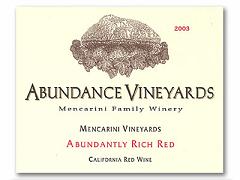 |
|
Wine Details
Price:
$14.00 per bottle
Description:
The 2003 Abundantly Rich Red is made entirely from our Mencarini Family grapes in Lodi. This vintage of our famous Rich Red is another stellar addition to our reputation for producing outstanding, value oriented wines. The rich blend of old California varietals Zinfandel and Carignane leaves nothing to the imagination. This wine is loaded with intense fruity aromas of Bing cherries, plums and blackberries in contrast with chocolate and toasty aromas contributed by the judicious use of oak barrels. The mouth feel is full with soft, ripe tannins, and the finish is long and almost sweet without being sugary.
|
|
|